Before venturing on the Everest Base Camp Trek, you must have an idea of what to expect in altitude, logistics, and overall experience. The EBC Trekking 14 Days ranks as one of the world's most iconic trips, a thoughtful-paced trek well-suited for trekkers of all ages and abilities. Regardless, the way to get to the trek, altitude plays a crucial role, which every trekker should be informed of.
How High is Everest Base Camp?
The height of Everest Base Camp (EBC) is 5,364 meters (17,598 feet) above sea level. Located in Nepal's Khumbu district, this high-altitude trekking site is the beginning of mountaineering climbs to Mount Everest.
While the Everest Base Camp trek is non-technical and suitable for most fit walkers, serious altitude considerations are needed at such a high elevation. That is why our 14 days Base Camp Trek itinerary includes acclimatization days in Namche Bazaar and Dingboche, to let your body acclimatize naturally.
Good acclimatization, hydration, and pacing are the secrets to safely reaching EBC successfully.
How to Reach Everest Base Camp?
Reaching Everest Base Camp starts with an exciting flight from Kathmandu to Lukla, the gateway to the Khumbu valley. The sole way to reach Everest Base Camp from Lukla is by walking, on a well-graded trail through Sherpa towns, ancient monasteries, suspension bridges, and alpine forests.
There are several other routes to reach Everest via road as well, if you are looking for a unique extended journey. Check out Ways to reach EBC to know more.
Everest Base Camp trekking route passes through famous locations including Phakding, Namche Bazaar, Tengboche, Dingboche, and Lobuche before reaching Everest Base Camp on Day 8 or 9 of your trekking.
The Nepal trek to Everest Base Camp is part of the larger Sagarmatha National Park, a UNESCO World Heritage site. If you want more information on the flight details, then you can skip directly to our Lukla Flight information section below.
When is the best time to trek Everest Base Camp in 2025 and 2026?
Choosing the best time of year can make or break your adventure to the Everest Base Camp. For great weather, clear skies, and safe conditions, the ideal times to trek to Everest Base Camp are spring (March to May) and autumn (mid-September to November).
During spring, the lower elevation areas like Namche Bazaar have 10°C to 15°C daily temperatures and can drop to -5°C at night in higher camps. The Everest region is filled with blooming rhododendrons and grand mountain views. The clear sky rewards one with stunning vistas of Mount Everest and other Himalayan giants.
Autumn is another great time. The monsoon rains will have washed away the dust and pollution, leaving crisp air and dramatic visibility. Day temperatures are still pleasant—12°C to 16°C in lower elevations and -10°C to -5°C at the higher elevations. Trails are dry, making it a great option for beginners and experienced trekkers alike.
Although we operate the Everest Base Camp trek package all year long, we suggest you avoid the monsoon months (June to August) due to excess rain, slippery trails, and also winter (December to February) when nights can get extremely cold below -20°C at Everest Base Camp and Kala Patthar.
However, it is possible to embark on the journey to the EBC during these months as well, with thorough preparation. Please check or blog, If you want to learn more about the best time for Everest Base Camp trekking.
What to Expect the Weather on the Everest Base Camp Trekking Trail?
The weather on the trail of the Everest Base Camp trekking is very varied in terms of altitude, season, and even time of day.
Ranging from sunshine heat to sudden snow flurries, you can experience a mix of climatic conditions while ascending from Lukla (2,860m) to Everest Base Camp (5,364m).
The Lower Everest region's days are pleasantly warm during peak months between 10°C and 16°C, particularly spring and fall. But the moment you cross 4,000 meters, daytime temperatures drastically drop, typically between 0°C and 5°C, and night temperatures drop down to -10°C or even lower.
In the area surrounding Gorak Shep and EBC, mornings and evenings are particularly cold, even during the best of trekking seasons. Clear mornings may turn into cloudy afternoons or snow at higher levels. That's why a layered clothing system is most important for temperature management and convenience.
How Difficult Is the Everest Base Camp Trek?
Our Everest Base Camp Trek difficulty level is a moderately strenuous activity that takes you through remote Himalayan wilderness, high-altitude conditions, and turbulent terrain.
With proper preparation, realistic pacing, and professional guidance, this Tour Package is well within the reach of most healthy and active people.
This 14 day Everest Base Camp trek is not technical mountaineering, hence it is within reach even for beginners with a passion for adventure.
You’ll be hiking an average of 5–7 hours per day on well-marked trails, gradually gaining elevation while adjusting to thinner air. To help with this, our carefully designed itinerary and cost plan includes proper acclimatization stops, rest days, and expert support.
If you want to entirely skip the walking or you think you are physically unfit to undertake the 14 days itinerary of the EBC, then check out our Everest Base Camp Heli tour, which takes you to the Base Camp of Everest without any hiking.
Elevation Profile and Terrain
The trekking route of Everest Base Camp starts from Lukla at 2,860 meters and ascends up to as high as Everest Base Camp at 5,364 meters with a side trek to Kala Patthar at 5,644 meters for breathtaking panoramas of Mount Everest.
You will ascend gradually over the course of the next 14 days through popular Sherpa villages like Namche Bazaar, Tengboche, and Dingboche, adding height progressively so that your body has time to adapt.
The landscape itself is made up of forest tracks, rocky ridges, suspension bridges, moraines, and glacial rims.
Can Beginners Do Everest Base Camp Trek?
Yes, absolutely! Many beginner trekkers complete the Everest Base Camp trekking itinerary successfully. It is a perfect trek for adventurous beginners who are ready to challenge themselves in one of the world's most stunning settings.
No mountaineering skills and no experience of high-altitude trekking are needed. It just requires a good physical shape, strong determination, and enough time for preparation.
With proper acclimatization days, nutritious meals, and expert planning, even novice hikers can complete the journey to base camp successfully and safely.
However, if you want to start with something easier, then consider our Everest View trek, which takes you the closest to Mount Everest in less than a week. If you are still confuse then check our blog on Everest Base Camp Trek for Beginners to get the details information.
What is Our Support for Different Fitness Levels on trek?
Our Everest Base Camp Trekking Package is structured to cater to all levels of fitness. If you are an experienced adventurer or a beginner going on your initial Himalayan trek, we customize the pace, provide acclimatization support, and ensure personalized attention every step of the journey.
We offer pre-trek training recommendations, personal itinerary preparation, and daily well-being check-ins during the trek. Our guides are also trained in altitude-related first aid and closely monitor your well-being as you trek higher.
Regardless of your trekking style - solo, group, or family - our team ensures your Everest Base Camp tour includes the best of service and care so that your 2025/2026 adventure is safe, rewarding, and memorable. As we are prode to have 99% sucess rate on this adventure for the better understaing our trust read our TripAdvisor Reviews.
How to Prepare for a Safe and Successful Trek to Everest Base Camp?
A successful Everest Base Camp Trekking is not just a stroll; it's an adventure that needs preparation, physical and mental. From physical fitness and packing tips to insurance and acclimatization at altitude, all need thorough planning.
You will first want to check your physical ability in terms of walking and prepare yourself accordingly. You can begin by going on short hikes and doing some cardio workouts to train your lower body. Please read our blog on How to Prepare Everest Base Camp trek for the details guide.
How Can I Get Fit for the EBC Trek?
You don't need to be a world-class athlete to do the Everest trek to base camp, but you do need to have a fair level of endurance, stamina, and determination. The trek is 5–7 hours a day for a few days, involves climbing higher altitudes, and walking above 5,000 meters of height.
Training at least 6 to 8 weeks before your Everest trkking is highly recommended. Include cardiovascular exercise such as hiking, running, cycling, or swimming. Day hiking on the weekends with a 6–8 kg pack is excellent training.
Altitude affects everyone differently. Even a healthy person may get altitude sickness; that's why a gradual and moderate strategy and acclimatization included in our Everest Base Camp Trek Package are crucial to a successful adventure. Read the details on our blog about the Everest Base Camp Training guide.
What Should i pack for my Everest Base Camp Trek?
For the Nepal Everest Base Camp trek, packing is as important as physical fitness. The limit of 12 kg per trekker is allowed, shared between two persons and one porter. We provide you with a 70 liter duffel bag and a warm sleeping bag to use on the trek. The things that you don't require can be left behind at our Kathmandu hotel or the Himalayan Recreation office, at no cost.
Your essential Everest trekking gear should include:
- Down jacket and insulating layers
- Waterproof shell and leggings
- Trekking boots (previously broken in)
- Several pairs of moisture-wicking socks
- Warm hat, gloves, and sun hat
- Sunglasses and sun cream
- Headlamp with back-up batteries
- Personal toiletries and medications
- Trekking poles (optional)
- Small daypack for personal use
We also recommend a power bank that can be held in one's hand, refillable water bottles with purification tablets, and snacks as other energy sources on the trail. Proper gear makes your Everest Base Camp Trek 2025/2026 safer and much more comfortable.
For the 14 days trek to EBC, You can reach out to us for a detailed packing checklist, or check our Everest Base camp trekking packing checklist for details.
Do I Need Travel Insurance for 14 days Hiking and What Should It Cover?
Yes, everyone on our Everest Base Camp tour package needs travel insurance. Your policy must have emergency medical evacuation to 5,500 meters and medical coverage.
Having good coverage helps you relax, allowing you to embark on your adventure with confidence, knowing you are protected in the event of illness, altitude sickness, or any other unforeseen circumstance.
In selecting travel insurance for the EBC trek, ensure your policy has:
- Helicopter evacuation coverage up to 5,500 meters
- Accident and illness coverage
If you're unsure, we’re happy to guide you on the best providers for the Everest trek in Nepal.
How is the Trekking Safety & Altitude Sickness Management on Everest Base Camp Trek?
What Is AMS and What Are the Symptoms?
Acute Mountain Sickness (AMS) is the body’s reaction to the lower oxygen levels at higher elevations, which can affect anyone, even experienced trekkers. On the Everest Base Camp Trek, where you’ll reach elevations over 5,000 meters, the symptoms of AMS often start mild but can worsen quickly if ignored.
Typical symptoms include:
- Headache
- Dizziness or lightheadedness
- Loss of appetite
- Nausea or vomiting
- Shortness of breath at rest
- Disturbed sleep
It's crucial to notice these symptoms early during your Everest Base Camp journey. The trick is not to ascend higher if symptoms appear, and never try to "tough out" AMS. Our guides are specially trained to monitor AMS and take swift action if there are any symptoms.
How Do We Prevent Altitude Sickness During the EBC Trek?
Your safety is our top priority on the Everest trek in Nepal. Our guides at Himalayan Recreation are high-altitude first aid trained and have years of experience leading the Everest Base Camp Trek in Nepal. Here's how we ensure your Trek Package is as safe as it is unforgettable:
- Our 14 days Everest Base Camp trek itinerary includes well-designed acclimatization stops in places like Namche Bazaar and Dingboche. These extra days help your body adjust safely to altitude, reducing the risk of AMS.
- During your trek to Everest, our guides conduct daily health assessments. We’ll check oxygen saturation levels, ask about symptoms, and decide if you’re fit to continue.
- If you're unwell, we'll alter your schedule or pace straight away. Your safety always comes first.
- We employ communications equipment to coordinate quick responses to any situation arising during your EBC trek.
What If There's an Emergency or Evacuation Needed during the trek?
Even with careful planning, sometimes emergencies do happen on the Everest Base Camp Trek. Our guides carry a comprehensive first-aid kit and are well trained to treat AMS or other symptoms of illness on the trail.
In the event of evacuation, Himalayan Recreation can arrange a helicopter rescue from anywhere on the Everest trekking route to bring you prompt medical attention in Kathmandu.
Our prime concern is to make your Everest Base Camp a memorable holiday while ensuring your health and safety throughout your Himalayan journey.
Lukla Flight Information: What Every Trekker Should Know?
Where Do Lukla Flights Take Off From?
Your Everest Base Camp trek is launched with one of the world's most famous short flights. However, the take-off airport of Lukla differs according to the trekking season in Nepal:
High Season (Spring and Autumn)
- The major trekking season, March to May and September to November, is when all flights to Lukla are operated from Ramechhap Airport (Manthali) instead of Kathmandu.
- Ramechhap is a 4–5 hour drive from Kathmandu, so we provide private, comfortable transportation for our trekkers, departing early to catch early morning flights.
Low Season (Monsoon and Winter)
- In December–February and June–August, flights are generally in direct operations from Kathmandu to Lukla, and the journey is more convenient.
- However, weather may still play a spoilsport at times, and hence, be prepared even during the off-season.
Himalayan Recreation will take care of all logistics for your Everest Base Camp trek package so that there is a hassle-free transfer to whichever airport your flight is operated from.
Baggage Allowances on Lukla Flights
Flights to Lukla are very weight-restricted since the runway is short and the aircraft are small on the Everest trekking path. Our package include your Weight Limit for the flight is 15 kg (10 kg checked luggage + 5 kg hand carry). There are extra baggage fees if you are over this weight, usually USD 1–2 per kilo over.
To make your Everest Base Camp trekking 14 days experience easier:
- We provide you with a duffel bag to pack your trekking gear.
- We store unnecessary items safely at our hotel or Himalayan Recreation's Kathmandu office at no cost.
- Our porter service divides the load between two trekkers, making the load easy and enabling you to relax and enjoy the trek.
Lukla Flight Delays and Cancellations
Weather in the Himalayas is unpredictable, even in the best seasons, which can lead to flight delays or cancellations between Kathmandu (or Ramechhap) and Lukla. For your Everest trek to base camp, always plan 1–2 extra buffer days at the end of your Everest Base Camp Trekking itinerary to avoid the risk of missing your international flight due to Lukla weather delays.
We will handle any flight rescheduling or extra accommodation, ensuring your Himalayan adventure remains stress-free, even if plans change unexpectedly.
Helicopter Transfer Option
If you find yourself with limited time or encounter prolonged flight cancellations, We offer you the Helicopter flight at the extra cost. A helicopter transfer to Lukla is an excellent alternative for continuing your Everest Base Camp experience.
The cost of the Helicopter flight to Lukla is around USD 550–700 per person (depending on group size and availability). There are certain advantages of the helicopter flight over the regular flight:
- Quicker transfer with fewer weather restrictions.
- Stunning bird's-eye views of the Himalayas as your journey commences.
- Greater flexibility to maintain your Everest Base Camp trek schedule on track.
What to Expect on a Typical Day at Everest Base Camp Trip?
From sunrise to sunset, a typical day on the Everest Base Camp Trip is filled with spectacular moments. All our 13 night 14 days Everest base camp trip follow almost the same routine, except for the two acclimatization days.
Your 14 days trip will begin your day with breakfast in the presence of a magnificent Himalayan sunrise and then embark on a trek. Walking through diverse landscapes and witnessing breathtaking views at every turn, you will pass by several traditional Sherpa villages. On the way, you will enjoy a hearty lunch in one of the villages, and then continue steering toward home for a night. As the day comes to an end, you will get to witness the mesmerizing sunsets that paint the sky with vibrant shades.
As for the acclimatization days, they are more leisurely. You will have an optional hike to nearby places to help you acclimate to the altitude better. You can stroll around the villages and just enjoy the unique culture and surroundings during these two days.
How is Accommodation on your 14 Days Everest Base Camp Trek?
Throughout your Everest Base Camp Trek, you'll be staying in a mix of good-quality hotels and local teahouse lodges, which will have you feeling close to the nature of the Himalayas.
In Kathmandu, you will stay in a good-quality 3-star hotel with modern amenities and a full breakfast included, just right for relaxing beforehand and afterwards from your Himalayan expedition.
During the trek, all accommodations are at locally owned tea houses along the Everest trail. our trek package include the simple but clean lodges with twin-bed rooms mix of Private and shared toilets. Blankets would be provided, but we recommend using the sleeping bag for extra warmth.
- Hot showers, Wi-Fi, and device charging are available at an extra cost. Although the internet service is slow and not extensive, it is good for uploading short Himalayan updates.
Charging Facilities
Our Most tea houses have electricity (solar or generator) where mobile phones, cameras, and power banks may be charged for a small fee (USD 2–3 per item). Bring a portable power bank, especially to high altitudes where electricity is limited.
For more advanced facilities during the trekking, you can choose to do our Luxury Everest Base Camp trek that includes luxurious accommodation and facilities while still offering you the adventure of hiking to the Mount Everest Base Camp.
How is Food on the Everest Base Camp Trek?
Your 14 Days Everest Base Camp Trekking Package includes three full meals a day, breakfast, lunch, and dinner, Tea and fresh fruits after dinner that are designed to sustain you during your trek.
Our package include three cup of tea, you can have tea with each meal for warmth and to keep you hydrated. however this package doest not include the drinking water, Anyway we are happy to provide the water purification tablets as per your request.
You will be provided with a variety of foods, vegetarian food is strongly recommended for better digestion and cleanliness in high altitudes.
- For breakfast, you can choose from Tibetan bread with honey or jam, Porridge, pancake, or cornflakes, Toast with eggs (fried, boiled, scrambled, or omelet), Chapati with honey, Tea, or coffee.
- The lunch usually includes Dal Bhat (Nepal's traditional rice, lentils, and vegetables), Fried noodles or pasta, Rice with curry (vegetable or sometimes meat), Sherpa stew (thukpa), Fried rice and eggs or vegetables.
- Similarly, dinner includes the option of Dal Bhat (believe us, you will come to love it!) Vegetable momos (dumplings), Soups (garlic, vegetable, noodle), Pizza (simple kinds that can be found in more populated villages, Pasta courses.
All food is freshly prepared and filling, providing you with the energy needed on the Everest trek. Remember that food choices slowly reduce as you ascend higher in elevation. You can read our blog on Food and Drinks on Everest Base Camp Trek.
Trekking Permits and Entry Requirements
We Handle All the Paperwork for the Everest tour so all you have to do is Focus on the Adventure. However, it is always better to know all the information in detail, so for the Everest Base Camp tour package, you require two permits to enter the region:
- Khumbu Pasang Lhamu Rural Municipality Entry Permit fees: NPR 3,000 per person (approx. USD 26)
- Sagarmatha National Park Entry Permit fees: NPR 3,000 per person (approx. USD 26)
All the required permits and paper works are already included in our 14 days trek package. However your visa is not included in this package and you can obtain the visa on arrival. If you want know more about permits, Visit our blog on Everest Base Camp Trek Permits and Fees.
How to Book Your Everest Base Camp Holiday?
Booking your Everest Base Camp Holiday in Nepal with Himalayan Recreation is simple, flexible, and completely secure. Whether you’re planning a private Everest Base Camp Trek Package, customizing your journey for special dates, or joining one of our guaranteed group departures, we’ve made the process hassle-free.
Himalayan Recreation is a fully licensed operator, registered with all relevant authorities in Nepal, including TAAN (Trekking Agencies’ Association of Nepal), NMA (Nepal Mountaineering Association), and the Department of Tourism. Book with complete confidence for your 14 days Everest trek to base camp adventure.
Deposit, Balance & Payment Methods
To secure your Everest Base Camp Trek Package, we require:
- Your need choose your preferred depature date and fill the form with details.
- Pay 20% deposit of the total trek cost at the time of booking.
- The remaining 80% balance can be paid after you arrive in Kathmandu during our pre-trek meeting. We Suggest you to bring USD cash for the remaning blance and extra expenses.
- We accept multiple secure payment methods for your convenience: Bank Transfer, Credit/Debit Card, Online Payment Gateways (e.g., Wise, Remitly, WorldRemit), and Cash (Nepalese Rupees or USD). However, the easiest form of payment is USD.
- You need to send us all your team member passport copies just after booking your trek.
- Free Date Changes: Postpone your trek without fees if unexpected situations arise.
If you need any assistance with booking your Everest Base Camp trek, please don't hesitate to contact us via Email or WhatsApp. Our local EBC experts are available 24 hours and always happy to answer your questions and eager to welcome you to Nepal.
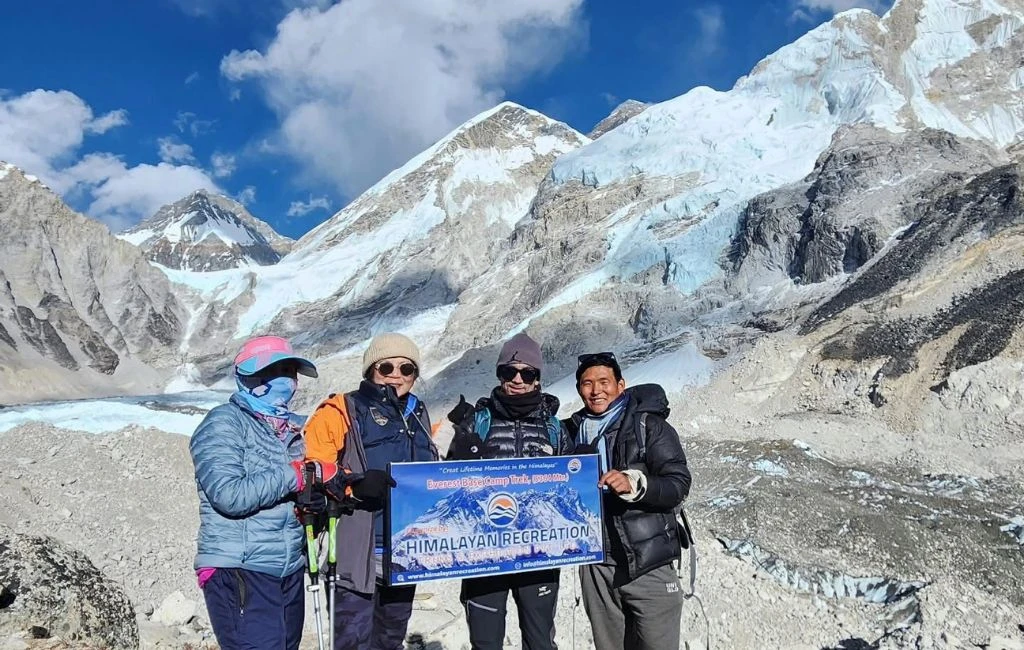


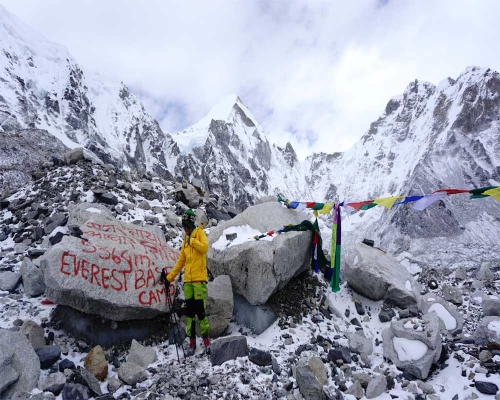
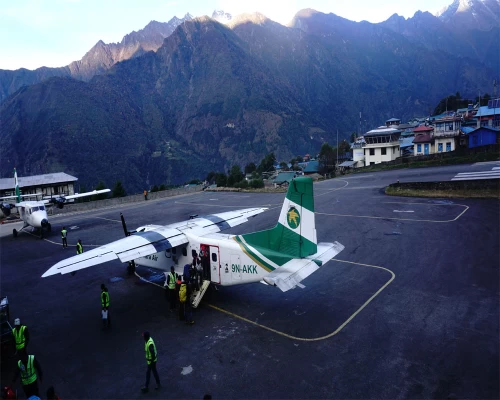
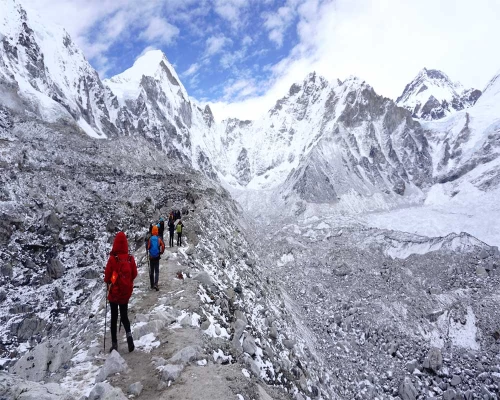
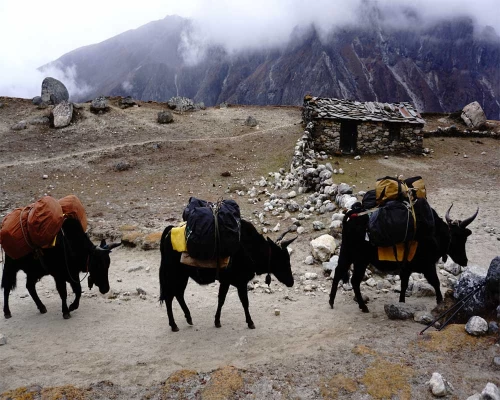
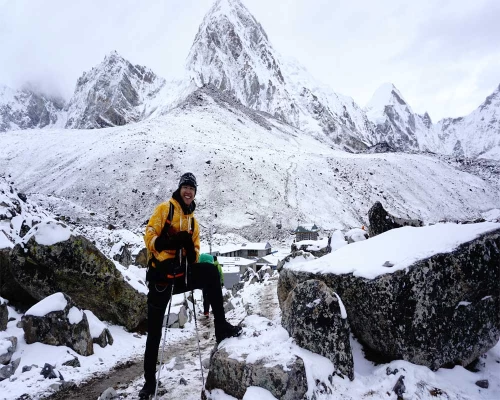
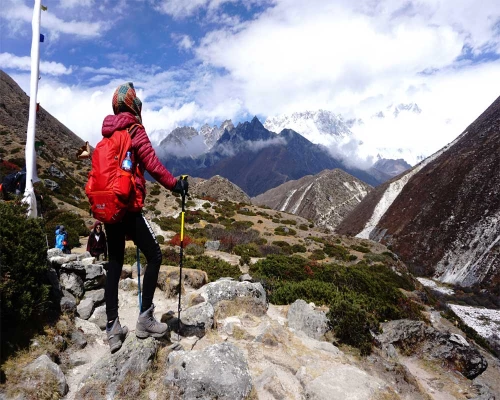















 5 reviews
5 reviews
